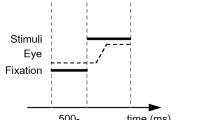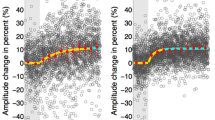Studies in 47 right-handed subjects with right and left leading eyes addressed the latent periods of visually-evoked saccades in the horizontal, vertical, and diagonal directions within the field of vision. Visual environments with three levels of temporospatial complexity and two standard time protocols of visual stimulation, with “gap” and “overlap,” were used. In subjects with left leading eyes, saccades were more often performed with shorter latent periods in the direction ipsilateral to the leading eye than in the contralateral direction (53% versus 20%); among subjects with right leading eyes, the proportions with decreases in the latent periods in the ipsi- and contralateral directions were different (25% and 22%, respectively). Thus, there was a relationship between eye dominance and the spatial asymmetry of the latent periods of saccades.
Similar content being viewed by others
References
N. N. Bragina and T. A. Dobrokhotova, Functional Asymmetry of the Human Brain [in Russian], Meditsina, Moscow, 2nd Edition, Revised and Updated (1988).
N. N. Bragina and T. A. Dobrokhotova, Left-Handers [in Russian], Kniga Ltd., Moscow (1994).
A. A. Vladimirov, Methods for Studies of Eye Movements [in Russian], Moscow State University Press, Moscow (1972).
O. V. Kolesnikov, L. V. Tereshchenko, S. A. Molchanov, A. V. Latanov, and V. V. Shulgovskii, “Relationship between the latent periods of saccadic eye movements and the complexity of the visual environment in humans,” Zh. Vyssh. Nerv. Deyat., 56, No. 2, 202–210 (2006).
V. F. Konovalo and N. A. Otmakhova, “Characteristics of interhemisphere interactions on imprinting of information,” Vopr. Psikhol., 4, 96–102 (1984).
A. P. Kulaichev, Computerized Electrophysiology [in Russian], Moscow State University Press, Moscow (2002).
I. E. Lazarev and A. V. Kirenskaya, “Effects of the leading eye factor on the characteristics of saccades and slow EEG potentials,” Fiziol. Cheloveka, 34, No. 2, 1–11 (2008).
I. V. Larin, V. G. Stepanov, and E. A. Khatemlyanskaya, “Determination of right- and left-handedness in terms of motor response asymmetry,” Zh. Vyssh. Nerv. Deyat., 45, No. 3, 608–611 (1995).
L. I. Leushina, A. A. Nevskaya, and M. B. Pavlovskaya, “Differences in the means of processing visual information in the right and left hemispheres,” Psikhol. Zh., 3, 81–94 (1981).
V. V. Moiseeva, M. V. Slavutskaya, and V. V. Shulgovskii, “Lateral differences in the latent periods of saccades on monocular presentation of stimuli with ‘overlap’ in the leading and non-leading eyes,” Zh. Vyssh. Nerv. Deyat., 53, No. 1, 33–40 (2003).
H. Beydagi, A. Yilmaz, and C. Suer, “The effect of direction on saccadic eye movement parameters,” J. Basic. Clin. Physiol. Pharmacol., 10, No. 1, 73–77 (1999).
R. M. Bracewell, M. Husain, and J. F. Stein, “Specialization of the right hemisphere for visuomotor control,” Neuropsychologia, 28, No. 8, 763–775 (1990).
T. S. Constantinidis, N. Smyrnis, I. Evdokimidis, N. C. Stefanis, D. Avramopoulos, I. Giouzelils, and C. N. Stefanis, “Effects of direction on saccadic performance in relation to lateral preferences,” Exp. Brain Res., 150, No. 4, 443–448 (2003).
A. Delinte, C. M. Gomez, M. F. Decostre, M. Crommelinck, and A. Roucoux, “Amplitude transition function of human express saccades,” Neurosci. Res., 42, No. 1, 21–34 (2002).
H. Deubel and W. X. Schneider, “Saccade target selection and object recognition: evidence for a common attentional mechanism,” Vision Res., 36, No. 12, 1827–1837 (1996).
J. Goldring and B. Fischer, “Reaction times of vertical pro-saccades and antisaccades in gap and overlap tasks,” Exp. Brain Res., 113, No. 1, 88–103 (1997).
H. Honda, “Idiosyncratic left-right asymmetries of saccadic latencies: examination in a gap paradigm,” Vision Res., 42, 1437–1445 (2002).
J. T. Hutton and J. Palet, “Lateral saccadic latencies and handedness,” Neuropsychologia, 24, 449–451 (1986).
F. Jagla, V. Zikmund, T. R. Mashonkina, and N. A. Yakimoff, “The accuracy of saccadic eye movements is associated with their horizontal and vertical direction,” Bratisl. Lek. Listy, 93, No. 6, 287–377 (1992).
M. Kinsbourne, Evolution of Language in Relation to Lateral Action. Asymmetrical Function of the Brain, M. Kinsbourne (ed.), Cambridge University Press, New York (1978), pp. 553–565.
M. I. Posner, “Orientation of attention,” Quart. J. Exp. Psychological., 32, 3–25 (1980).
M. F. Rushworth, A. Ellison, and V. Walsh, “Complementary localization and lateralization of orienting and motor attention,” Nat. Neurosci., 4, No. 6, 656–661 (2001).
J. D. Schall and N. P. Bichot, “Neural correlates of visual and motor decision processes,” Curr. Opin. Neurobiol., 8, 211–217 (1998).
D. L. Sparks, “The brainstem control of saccadic eye movements,” Nat. Neurosci. Rev., 3, 952–964 (2002).
C. P. Talgar and M. Carrasco, “Vertical meridian asymmetry in spatial resolution: visual and attentional factors,” Psychon. Bull. Rev., 4, 714–722 (2002).
A. Tzelepi, Q. Yang, and Z. Kapoula, “The effect of transcranial magnetic stimulation on the latencies of vertical saccades,” Exp. Brain Res., 164, 67–77 (2005).
W. Zhou and W. M. King, “Attentional sensitivity and asymmetries of vertical saccade generation in monkey,” Vision Res., 42, 771–777 (2002).
Author information
Authors and Affiliations
Corresponding author
Additional information
Translated from Zhurnal Vysshei Nervnoi Deyatel’nosti imeni I. P. Pavlova, Vol. 59, No. 5, pp. 547–556, September–October, 2009.
Rights and permissions
About this article
Cite this article
Kolesnikova, O.V., Tereshchenko, L.V., Latanov, A.V. et al. Effects of Visual Environment Complexity on Saccade Performance in Humans with Different Functional Asymmetry Profiles. Neurosci Behav Physi 40, 869–876 (2010). https://doi.org/10.1007/s11055-010-9342-0
Received:
Accepted:
Published:
Issue Date:
DOI: https://doi.org/10.1007/s11055-010-9342-0




